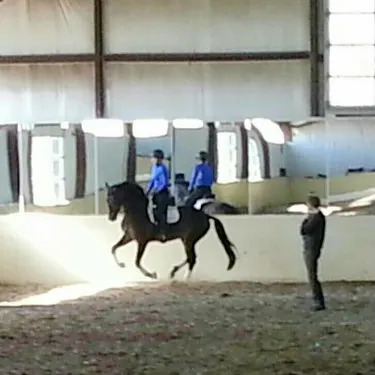I can hardly believe we are already back into May! Time flies and is always getting away from me. We just had our last of the six foals we were expecting this year and thankfully all are healthy, and hilarious to watch.
The World Cup Finals in Vegas were really fun to watch as well. The best part was getting the behind-the-scenes pictures from all my friends that went. However, for us there was the incredible fringe benefit that Rudolf Zeilinger was in the United States for the World Cup, and decided to make a pit stop in Kansas after Vegas.
I know, who doesn’t want to come to Kansas after Vegas, right?! Linda Landers, a cornerstone of our dressage community, and Michael Beining are friends of Rudolf, and they used to bring him to the Midwest for clinics and finally, after 26 years, they convinced him to return. I feel exceptionally lucky to have ridden with him.
The man is a genius. I guess if you look at his resume of training so many Grand Prix horses that went on to international competition, having so many successful riders and being coach of the Danish team for over 15 years, it is no surprise.
The best way to describe the lessons were that he could absolutely feel what he saw. There was no trying to hide anything, and it was such an amazing, wonderful feeling. You know when you have the feeling your horse is about to get a small breakthrough? Well he could see it and tell it was close too.
He was also quick to say “OK, stop, that’s not working.” He could read the horses and know when to react and when to ignore. His method was quiet and classical but he also said sometimes theory and practical diverge but you always have the goals in your mind.
ADVERTISEMENT
The top three things I heard:
1. “Light hands.” Be allowing. But be active and present; quick and clever. Sherbert (an 8-year-old Sir Donnerhall gelding from Leslie Waterman who is going in the Prix St. Georges) starts to get heavy and almost too stagnant in the connection, so we did little flexions and let go, but kept my hands totally down and worked to get to the point of giving and allowing.
Quebert gets strong so one time we rode him really deep and with tons of bend to keep him from pulling. We always were incorporating the hind legs so he became more even throughout his whole body. But the next day my hands came really very high to try to take his leverage to pull away. High hands were for as short a time as possible, but as long as you need. And they’re still always light and giving if there was ever a chance. Also, if he just started barreling I was allowed to use my reins, with my seat, to make a strong half-halt, but I had to be giving and light again the split second before he came back.
Finally, on ET, who is maybe not perfectly steady in the higher, more collected connection, my job was to be his solid rock and let him find it. He is coming 6 and we were schooling piaffe-passage transitions so I was thrilled. Rudolf believes it really takes about four years to develop the piaffe and passage…so starting early is key!
2. “On your seat” is self-explanatory but oh so difficult! It is the pinnacle of his training. His position is amazing and with legs that are outlandishly long. I am at once totally impressed he can control them and totally jealous. Your seat had to be able to completely maneuver the horse. With nearly every horse he used the shoulder-in on a circle or giant turn on the forehand to engage the horse’s hind legs, but also to put the rider in a true feeling of inside leg to outside rein.
Using this he would do transitions from big trot on 20-meter circle to half steps on a 10-meter circle—all within the shoulder-in. This keeps the horse supple, using his back and accepting of the aids while allowing the rider to find moments to give, be light, and let the horse dance his own dance.
ADVERTISEMENT
3. He said the most simple but amazing thing: “If you find yourself working backwards, just change the subject to put yourself back in a position of driving and focusing on forward.” In this instance it was that the horse got too strong in piaffe, so I was thinking ‘wait, slow, stop’ instead of ‘go.’ It is an easy concept but you have to be creative (and not stubborn) to put it into practice. It requires a thinking, create, clever rider, which is what he wanted!
Unfortunately, there were two very disappointing things. First, he said he was simply too busy to make any plans to come back (trust me… we begged). I totally understand but then I asked him what he would suggest for me to do… who could he recommend that I work with? What would he suggest as a next step?
He gave me no answers. I hope it was because he honestly didn’t know; not that he didn’t care.
Second, I wish more auditors would have been able to come. It was a weekday clinic so I know it is tough but I feel it was a missed opportunity.
Hopefully we are ready for the first shows of the season this weekend!
Blogger Emily Miles shows and trains dressage horses out of her family’s farm in LaCygne, Kan. Her WakeUp is one of the rising stars of U.S. dressage, having won the 6-year-old national championship in 2011 and winning the Developing Prix St. Georges national championship in 2013. Read all of Emily’s blogs.















